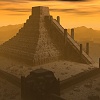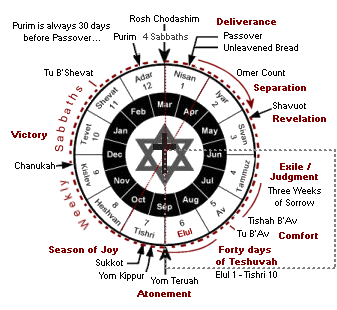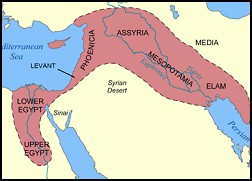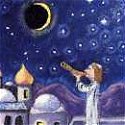|
On the 6th Sivan, exactly 49 days after the Exodus, the LORD revealed Himself on Mount Sinai. All of Israel (600,000 heads of households and their families) heard the LORD speak the first two of the Ten Commandments. Following this initial revelation, Moses re-ascended Sinai for 40 days to receive the remainder of the Torah. This date coincides exactly with the festival of Shavuot. Upon descending Mount Sinai and witnessing Israel's worship of the Golden Calf, however, Moses smashed the Tablets inscribed with the Ten Commandments and burned the Golden Calf (Exod. 32:19-20, Seder Olam 6, Taanit 30b, Rashi). This tragic episode corresponds with Tammuz 17, a date associated with many calamities in later Jewish history....
On the Biblical calendar, the fourth month of the year (counting from Nisan) is called Tammuz (ū¬ų╝ųĘū×ų╝ūĢų╝ū¢) in Jewish tradition. The name "Tammuz" is of Sumerian origin (as are the other names of the months in the Jewish calendar). Since Abraham was the son of a Sumerian priest, it should come as no surprise that Mesopotamia (and later, Babylon) came to be regarded as the ancestral homeland of the Jewish people (Gen. 11:28). The Torah states that until Abraham arrived in Canaan, the ancestors of Israel "served other gods" (Josh. 24:2), and these "gods" were part of ancient Near East mythology that derived from ancient Babel in the land of Shinar (Gen. 10:10). Hence we see Rachel stealing her father's idols (i.e., "teraphim," ū¬ų╝ų░ū©ųĖūżų┤ūÖūØ) before fleeing Haran (Gen. 31:19), and we see Jacob later commanding his family to "put away the foreign gods among you" (Gen. 35:2). It's clear, then, that the influence of this ancient religious system extended long before the captivity of the Jews under Nebuchadnezzar II in the 6th century BC, though certainly the Jews adopted the idea of a "fixed" calendar based on Babylonian astronomy.

Some scholars identify Tammuz as the Sumerian sun god (Shamash or Dumuzid), the consort of Inanna (i.e., Ishtar), who was thought to be responsible for the seasonal life/death/rebirth cycle. Beginning with the summer solstice, the Sumerians marked the decline in daylight hours with a six-day "funeral" for Tammuz, and this idolatrous custom was apparently adopted by some Jews during the days of the First Temple. Therefore the prophet Ezekiel condemned the worship of Tammuz as one of the reasons for God's anger against His people (Ezek. 8:14). Ezekiel further forewarned that the Temple would be destroyed if the people refused to repent from thinking about the LORD using ancient pagan assumptions...
Tragically, the idolatry persisted despite the prophets warnings, and on Tammuz 9 the walls in Jerusalem were breached by Nebuchadnezzar's armies. Because of the siege, on Tammuz 17, the Temple service itself was disrupted due to a lack of animals required for the sacrifices. The Temple itself was destroyed three weeks later, on the Ninth of Av.

The Beginning of the Three Weeks of Sorrow
The fast of the 17th of Tammuz (Shivah Asar B'Tammuz) marks the beginning of the "Three Weeks of Sorrow," a 21 day period of national mourning which is completed on Tishah B'Av. The Mishnah further associates the 17th of Tammuz as the "Fast of the Fourth Month," mentioned by the prophet Zechariah (Zech. 8:19). The purpose of this fast is to instill a sense of teshuvah (repentance) by recalling specific tragedies that befell the Jewish people because of idolatry.

The period between the fourth and fifth months is a somber time of reflection for many Orthodox Jews. The three weeks from Tammuz 17 to the Av 9 is called bein ha-Metzarim (ūæų╝ųĄūÖū¤ ūöųĘū×ų╝ų░ū”ųĖū©ų┤ūÖūØ) - "between the straights" (based on Lamentations 1:3), a period of time during which many calamities befell the Jewish people. Since both Temples were destroyed during this period (i.e., between the 4th and 5th months), the sages established this extended period as a time of mourning for the Jewish people.
Typically marriages are not held during this period, and many Jews deliberately refrain from ostensibly pleasurable activities, such as listening to music, dancing, taking vacations, and sometimes even shaving! In fact, most Orthodox Jews will refrain from any activity that might require the recitation of the Shehecheyanu blessing.
In short, the Three Weeks of Sorrow is a time for reflection and mourning over the destruction of the Temple and therefore constitutes a time of corporate reflection intended to lead Israel to teshuvah.
Why Babylonian Names?
The Talmud Yerushalmi states: "The names of the months came up with us from Babylon" (Rosh Hashanah 1:2). In commenting on this statement, the sages said that at first the reckoning of the months was originally a memorial to the Exodus from Egypt. In the Torah, "the first month, the second month," etc. are understood in relation to the new moon of the first month of Spring (i.e., Rosh Chodashim). However, after the Jews returned from exile in Babylon in fulfillment of Jeremiah's prophecy (i.e., "it will no longer be said 'as the LORD lives, who took the people of Israel out of Egypt,' rather it will be said 'as the LORD lives, who raised up and brought the people of Israel from the Northern Land' (Jer. 16:14-15), they began to call the months by the names commonly used in Babylon as a reminder of God's faithfulness. The month of Tammuz is peculiar, however, since it recalls the name of an idol that was worshipped in the Ancient Near East. The sages comment that this name was deliberately chosen to remind the Jewish people of the judgment that comes from idolatry -- beginning with the Golden Calf incident and later with the secret cult worship in "high places" (ūöųĘūæų╝ųĖū×ūĢų╣ū¬) that eventually led to the destruction of the Temple.
Note: Civilizations before Israel
The relationship between the Jews and ancient civilization is a fascinating study. Israel, of course, is not the oldest of the nations, even though Abraham's genealogy derived from the godly line of Seth -> Noah -> Shem (see here for more). According to Jewish tradition, Shem was an elder contemporary of Abraham who was called Malki-Tzedek, the first king of Jerusalem (Gen. 14:18). His blessing upon Abraham was thought to transfer regal authority to Israel as God's people upon the earth. The other descendants of Noah migrated away from Jerusalem, and the "cradle of civilization" therefore began in the land of Shinar under Nimrod (ūĀų┤ū×ų░ū©ūĢų╣ūō), who is called the first "king of the earth" (Gen. 10:10). Of Nimrod the Torah states, "the beginning of his kingdom was Babel" (ūĢųĘū¬ų╝ų░ūöų┤ūÖ ū©ųĄūÉū®ūüų┤ūÖū¬ ū×ųĘū×ų░ū£ųĘūøų░ū¬ų╝ūĢų╣ ūæų╝ųĖūæųČū£), the very location where the ziggurat to heaven was erected and from which the dispersion of the 70 nations occurred (Gen. 11:9).

The earliest civilization arose from ancient city states of the Fertile Crescent of the ancient Near East (Mesopotamia), extending from Sumer (in the east) to Egypt (in the south). It was in ancient Sumer that writing was first invented and the first schools were established. Abraham, the first Jew, was called out from the City of Ur (one of the city states of ancient Sumer, the easternmost "point" in the fertile crescent south of the Euphrates river) to the land of Canaan in the west. Because of a famine in the land, Abraham later "followed the crescent" south to Egypt for a season (Gen. 12:10). Joseph and the tribes of Israel later settled in Egypt before becoming enslaved by Pharaoh, and Moses himself was raised and educated as an Egyptian.... Even Yeshua lived in Egypt as a child (Matt. 2:14-15). The land of Canaan functioned as a "bridge" between the two great power centers of the ancient world (Mesopotamia and Egypt), and much of Israel's later history had to do with political entanglements between these world powers:
 |
The whole of human history (HIS-story) is the story of the redemptive love of a personal God who is the Creator of both space and time. The nation of Israel is metaphorically called the "firstborn son" of God that was chosen to prepare the world for the coming of the Messiah, the "Seed of Promise" (Exod. 4:22, Gal. 3:19). The revelation given at Sinai brought together the realm of spiritual reality with the realm of the material world. The concept of performing "mitzvot" is likened to a divine-human cooperative intended to "repair the world" (tikkun olam). Whenever we truly submit to the LORD as our King, we function as agents of His instrumentality and love in the world. Ethnic Israel was intended to be a "birth channel" of something greater still, namely, the complete unity between the upper and lower realms. Yeshua is the LORD "made flesh" and is therefore the only true Redeemer of fallen creation.
After the "fall" of Adam and Eve and their eviction from the Garden of Eden, the LORD prophesied that a cosmic struggle for the fate of humanity would ensue. Through his machinations, Satan (represented by the serpent) had arrogated a legal or forensic "right" to humanity, who were now under divine kelalah (curse). However, the LORD promised to rescind the curse by means of the Seed - the Mashiach - who would "crush the head" of the serpent and restore mankind to blessed paradise (Gen. 3:15). The entire redemptive story of the Scriptures is about the cosmic conflict to deliver humanity from the kelalah by means of the "Seed of the woman" who would come. The ancient history of Israel was intended to "get Yeshua to Moriah" - to the place of ultimate sacrifice - where He would offer up His life for the sins of the world, thereby breaking the "spell" of the curse.
Yeshua at Moriah is the Central Point of all history. It is the Altar. Yeshua's life, sacrifice, and resurrection was like a "magic spell" that "spoke backwards" the sin of the "First Adam" - and by means of His deliverance the power of the curse was forever broken. Satan's power was forever defeated by the "Second Adam," the Son of Man (2 Tim. 1:10).
Because of Yeshua, all people - regardless of their race, gender, or ethnic origin - are invited to become part of the family of God (Rom. 16:26). Yeshua alone gives us true peace with God (Rom. 5:1; 2 Cor. 5:21, 1 Tim. 2:5; 1 Pet. 3:18). The authentic practice of our faith is the means of truly repairing the world and furthering the Kingdom of God on earth. The outworking of humanity's spiritual history is therefore essentially a conflict between good and evil. Yeshua referred to it (among other things) as a conflict between the Kingdom of God (ū×ųĘū£ų░ūøūĢų╝ū¬ ūÉų▒ū£ūöų┤ūÖūØ) and the kingdom of Satan (John 8:34-6). The Apostles likewise spoke of "children of darkness" and "children of light" (Eph. 5:8; Col. 1:13, 1 Thess. 5:5, etc.). Politically speaking, St. Augustine described the cosmic conflict as one between the "City of Man" and the "City of God." Eschatologically, there will be a day of judgment in which the truth will be manifest forever (1 Cor. 4:5; 2 Cor. 5:10; Heb. 4:13). There is an "ethic" to our beliefs, chaverim. Our response to spiritual reality determines everything... Those who suppress the truth of God and deny His redemptive love are eternally liable for their decision.
|








